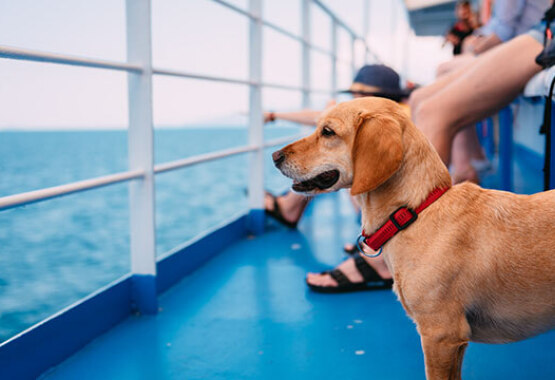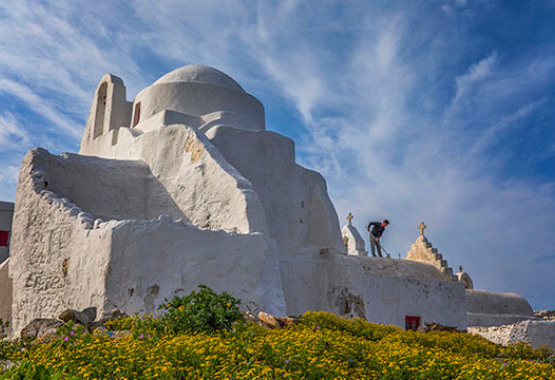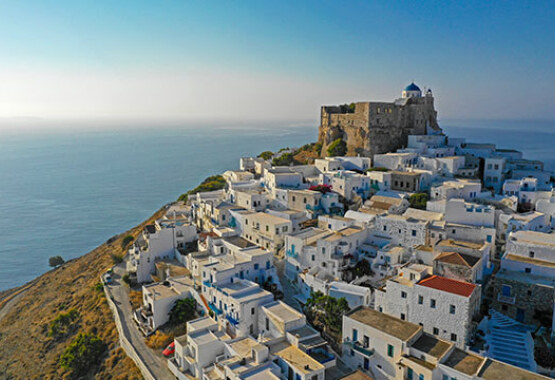Cultural tour on Paros
Cultural and natural sites go hand in hand.
Paros is by size the third island of the Cyclades group, combining natural beauty, culture and fun. The visitor can start his tour from Paroikia’s harbour, have some time to relax in the nice little coffee-shops lining the island’s picturesque alleys and then stop by the Archaeological Museum of Paros to get an idea about the history of the island that has been populated since the beginnings of the Late Neolithic Period, due to its location in the central Aegean.
Here is a short tour:
The Archaeological Museum –within walking distance from the harbour– is housed in a modern building constructed particularly to serve this end. The Paros Museum is one of the most important in the Aegean as it houses a detailed collection of works of plastic art dating to the Archaic and Classical times. Apart from works of art sculpted by local craftsmen in the Ionian style, using the renowned Paros marble, it also houses finds that have been unearthed during the excavations that began in the late 19th century and continued until the present day. These finds date to a time span that extends from the neolithic period (late 5th millennium) until the roman period (30BC–324 AD). Major works of ancient Greek sculpture stand out, such as the whole marble statue of Gorgo (mid 6th c. BC), the statue of Niki [Victory] (mid 5th c. BC) that gives the impression it has risen from the ground and two marble embossed plaques (late 6th c. BC) from the Memorial of Archilochos – a monument raised in honour of a Paros native who was one of the most significant representatives of lyric poetry. “Parion chronikon” (meaning “Paros Chronicle”) – a historic find – is an inscription on a marble slab, written in the attic dialect, where major historical and cultural events have been recorded.
• A few metres away from the Archaeological Museum, you will find the church of Panayia Ekatontapyliani or Katapoliani, one of the major orthodox places of worship in the Aegean. The excavations have corroborated the tradition that the original church was erected during the reign of Constantine the Great. It acquired its final form mostly during the reign of Justinian around mid 6th c. The Early Christian building complex comprises the central grand cross-domed basilica, dedicated to the Dormition of the Mother of God, its contemporary Áyios Nikólaos chapel located northeast and the subsequent Baptistery to the south. One can admire the quality of construction and decoration of the main church which is one of the very few Early Christian churches that have remained open for services to this day. The historical continuity between the ancient and medieval times is evidenced by the ancient architectural members integrated in the churches’ masonry. The complex is sided by small chapels and monastic cells in a two-storey building that date to the 17th and 18th century. Ekatontapyliani houses two important collections: the first one includes Early Christian sculptures and inscriptions from Paros and the second one is a small collection of post-byzantine art icons crafted in the traditional island style.
Explore some more!
Paros island is renowned not only for its archaeological and religious sights but also for its natural beauty. A great idea would be to explore Kolymbíthres beach, a natural scenery of exceptional beauty and biodiversity.
The beach lies pretty close to Náoussa and its “particularity” lies in the strange rock formations that surround it. The granite boulders look like natural sculptures, moulded through the millennia by the eroding forces of the sea, the wind and the sun.
The beach contains a number of successive small sandy coves with warm and shallow waters that are ideal for families or visitors of an older age, whereas some are so small that they can accommodate up to 2-3 people.
The best way, however, to fully enjoy the natural scenery, is to visit the beach in the morning or late afternoon hours, as it is a famous one and a favourite spot for many tourists.
If you seek the comfort of an umbrella or a deck chair, rest assured you will find everything you need, even restaurants or opportunities to practice water sports.
The nearby area is ideal if you like hiking, since you can follow the relatively easy route towards the Mycenaean acropolis of Koukounariés or the beach in Monastíri. If you choose to visit the nearby Environmental and Cultural Park of Paros you will be absolutely thrilled by the natural beauty and the high standard infrastructure designed by Paros municipality.





